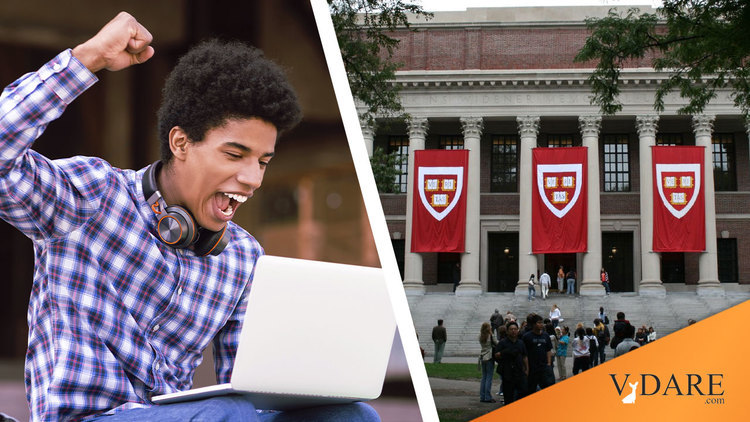Reader KR sends me data and graphs of 2014-2019 Harvard College undergraduate admissions as forcibly revealed by the current discrimination lawsuit headed for the Supreme Court:

I believe this data is from the latest NBER paper studying plain vanilla applicants to Harvard who aren’t jocks, Harvard professors’ children, legacies, or Jared Kushner–types with big checks attached.
The horizontal axis is Harvard’s ranking of applicants’ academic potential on a 1 to 10 scale.
Strikingly, over 40% of plain vanilla blacks in the top two academic deciles still get rejected.
I suspect in the interest of keeping up their “yields” (percent of accepted applicants who enroll) elite colleges still do a lot of covert signaling to each other of whom they want and expect to land so you’d better back off and not admit him.
The top 22 colleges used to meet each year to tell each other that until the first Bush Administration pointed out that was an obvious violation of anti-trust laws. The second tier schools still seem to do that more informally—after all, they are Good so the laws don’t really apply to them—but HYPS [Harvard-Yale-Princeton-Stanford—ed.] don’t seem to participate with their inferiors as much as in the 1980s. But maybe they signal with each other?
For example, my son went to a rigorous private high school. In his class, the brilliant valedictorian earned a 4-year full ride to Yale, but was not even accepted by Harvard.
If you are in the 5th decile academically (i.e., a little worse than average for a Harvard applicant), here are your chances:
|
5th decile applicants and admits |
||||
| Applicants | Admits | Admit Rate | Ratio vs white | |
| Black | 900 | 202 | 22.4% | 8.7 |
| Hispanic | 1,723 | 157 | 9.1% | 3.6 |
| White | 7,675 | 197 | 2.6% | 1.0 |
| Asian | 3,884 | 72 | 1.9% | 0.7 |
More blacks ranking in the fifth decile were offered admission than whites. And this was before the Racial Reckoning.
Traditionally, going back to W.E.B. Du Bois, Harvard tends to get a disproportionate share of the best black students, so these ratios might be even larger at lesser schools.
One thing to keep in mind about H-Y-P-S over the last 15 years or so is that, because their endowments are so vast, they now offer lavish financial aid (i.e., discounts off list-price tuition) for families making in the lower six-figure income range. They tend to be highly competitive in price with in-state flagship public universities for families at, say, the 75th percentile of income.
In contrast, second and third tier private colleges can’t afford to be so generous.













